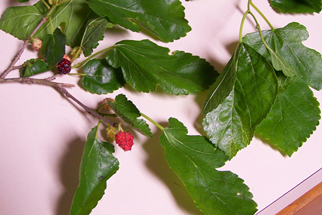Mulberry
May 19, 2018
![]()
I had a young tree transplanted in early March. It is a mulberry I think. I planted it when it was just a bare root twig 3 or 4 years ago, complements of the Arbor Day Foundation. Now it’s well over 15 feet tall. Question: The trunk and branches are green but there are no leaves. Is there something I should do? Will it live without leaves?
![]()
It will not live without leaves to manufacture food. We did have some setbacks this spring with late freezes and I am sure it has gone through a bit of shock of transplant. By now, most plants have rebounded and started to put on new foliage, but if there is still green wood, give it some more time to see if it leafs out. Water when dry, but if you see nothing by June 1, I would cut it back and see if it possibly sprouts back from the root system.
May 21, 2016
![]() Please help us identify this tree (pics attached). Over the weekend, the Cedar Waxwing
birds were having a feast on the berries, which resembled a small raspberry or blackberry.
We searched through the latest edition of "Trees of Arkansas" and could not find a
suitable match.
Please help us identify this tree (pics attached). Over the weekend, the Cedar Waxwing
birds were having a feast on the berries, which resembled a small raspberry or blackberry.
We searched through the latest edition of "Trees of Arkansas" and could not find a
suitable match.

![]() The plant in question is a mulberry tree. The fruit when totally ripe is edible for
human consumption too, but you will have a hard time beating the birds to it. Once
birds start feasting, they often send some messy missiles on patio furniture and the
like.
The plant in question is a mulberry tree. The fruit when totally ripe is edible for
human consumption too, but you will have a hard time beating the birds to it. Once
birds start feasting, they often send some messy missiles on patio furniture and the
like.
December 26, 2015
![]()
I have an old mulberry tree and the fruit for the past few years looks like popcorn. I went to a local nursery and they told me to try lime, but it didn’t make a difference. Do you have any suggestions to try for next year?
![]()
Without seeing the fruit I am going to say that lime was not effective because the problem was not related to a nutritional or pH deficiency but rather a disease or possibly insect. There are two potential causes—one is a disease and one is an insect. There is a disease commonly called popcorn disease of mulberry. It is caused by the fungus Ciboria carunculoides. Individual parts of the fruit called carpels are replaced by a fungal organism, which enlarge and extend beyond healthy berries. The resulting fruits look a bit like popped corn. Sanitation is your best method of control. Remove all the spent fruit from the tree and under it and destroy it. It wouldn’t hurt to spray the tree this winter with dormant oil. Then see what happens next year. While fungicides are not normally recommended there has been some success with a preventative spray of Bordeaux mix (a copper/lime fungicide) as the tree is leafing out. Another possibility is damage from a stink bug. These insects have a piercing-sucking type of mouthpart. In order to obtain the nutrients of the liquid part of the fruit, stink bugs use these mouthparts in a straw-like fashion by piercing the fruit. The resulting damage can cause individual parts of the berry to turn white and be damaged.
All links to external sites open in a new window. You may return to the University of Arkansas System Division of Agriculture web site by closing this window when you are finished. We do not guarantee the accuracy of the information, or the accessibility for people with disabilities listed at any external site.
Links to commercial sites are provided for information and convenience only. Inclusion of sites does not imply University of Arkansas System Division of Agriculture's approval of their product or service to the exclusion of others that may be similar, nor does it guarantee or warrant the standard of the products or service offered.
The mention of any commercial product in this web site does not imply its endorsement by the University of Arkansas System Division of Agriculture over other products not named, nor does the omission imply that they are not satisfactory.